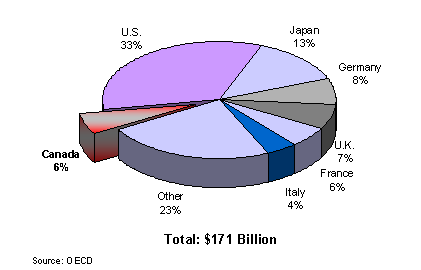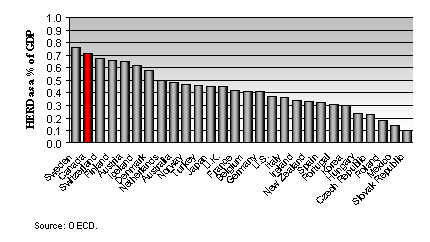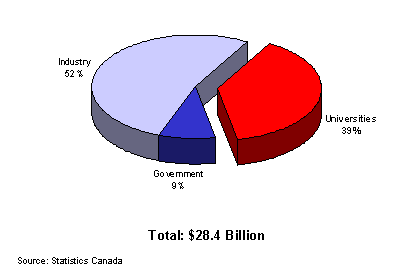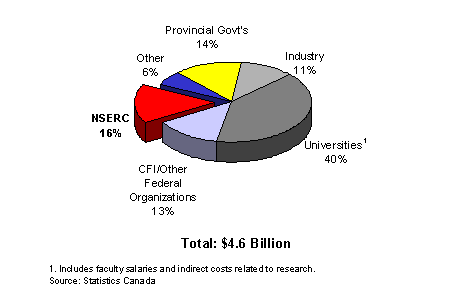Common menu bar links
Breadcrumb Trail
ARCHIVED - Natural Sciences and Engineering Research Council of Canada
 This page has been archived.
This page has been archived.
Archived Content
Information identified as archived on the Web is for reference, research or recordkeeping purposes. It has not been altered or updated after the date of archiving. Web pages that are archived on the Web are not subject to the Government of Canada Web Standards. As per the Communications Policy of the Government of Canada, you can request alternate formats on the "Contact Us" page.
Section 1 – Agency Overview
1.1 Minister’s Message
 I am pleased to present NSERC’s Departmental Performance Report for 2006–07.
I am pleased to present NSERC’s Departmental Performance Report for 2006–07.
My goal as Minister of Industry, and one of the top priorities of Canada’s New Government, is to ensure we maintain a strong economic environment – one that allows Canadians to prosper in the global economy. We are seeing great changes in the international marketplace. New trade agreements, rapidly advancing technologies and the emergence of developing countries are all contributing to today’s business environment. Canada needs to keep pace.
Part of my mandate is to help make Canadians more productive and competitive. We want our industries to continue to thrive and all Canadians to continue to enjoy one of the highest standards of living in the world.
For this to happen, the government is committed to maintaining a fair, efficient and competitive marketplace – one that encourages investment, sets the stage for greater productivity, and facilitates innovation. We are relying on market forces to a greater extent, regulating only when it is absolutely necessary. Our policies have helped turn research into new products and business processes. In addition, we are making efforts to increase awareness of sustainability practices among Canadian industry, emphasizing the social, environmental and economic benefits they bring.
The Department and the Industry Portfolio have made progress on a wide range of issues this past year, most notably in the areas of telecommunications, science and practical research, manufacturing, small business, consumer protection, patents and copyrights, tourism and economic development.
The Industry Portfolio is composed of Industry Canada and 10 other agencies, Crown corporations and quasi-judicial bodies. These organizations collectively advance Canada’s industrial, scientific and economic development, and help ensure that we remain competitive in the global marketplace.
We have accomplished much this year. Using Advantage Canada – the government’s long-term economic plan – as our roadmap, we have made great strides toward many of our most important goals. We will continue to focus on these goals to support the conditions for a strong economy – an environment that Canadians expect and deserve.
Jim Prentice,
Minister of Industry
1.2 Management Representation Statement
I submit for tabling in Parliament, the 2006–2007 Departmental Performance Report for the Natural Sciences and Engineering Research Council of Canada (NSERC).
This document has been prepared based on the reporting principles contained in the Guide for the Preparation of Part III of the 2006–2007 Estimates: Reports on Plans and Priorities and Departmental Performance Reports:
- It adheres to the specific reporting requirements outlined in the Treasury Board Secretariat guidance;
- It is based on the department's approved Strategic Outcome(s) and Program Activity Architecture that were approved by the Treasury Board;
- It presents consistent, comprehensive, balanced and reliable information;
- It provides a basis of accountability for the results achieved with the resources and authorities entrusted to it; and
- It reports finances based on approved numbers from the Estimates and the Public Accounts of Canada.
Suzanne Fortier, President
Natural Sciences and Engineering Research Council of Canada
1.3 Summary Information
Canada's prosperity depends upon people, knowledge and innovation, especially in science and technology, as we transform our economy from one based on commodities to one based on value-added products in all sectors. Science and technology will also continue to enhance our quality of life by helping us improve the management of our resources, environment, public education and health system.
NSERC is the primary federal agency investing in research and research training in the natural sciences and engineering disciplines. It is funded directly by Parliament and reports to it through the Minister of Industry.
Our mission is to invest in people, discovery and innovation to build a strong Canadian economy and to improve the quality of life for all Canadians. NSERC advances government-wide priorities of building a stronger Canada, creating opportunities for young Canadians and investing in knowledge and creativity.
Created in 1978, NSERC’s legal mandate, vision and mission are outlined in Figure 1.
The agency’s ultimate objective is to advance Canada’s prosperity and high quality of life by supporting the creation and transfer of knowledge in the natural sciences and engineering (NSE) in Canada, and by ensuring people are trained to use and create that knowledge. To achieve this, NSERC supports research in Canadian universities and colleges that meets the highest international standards of excellence and supports the education of young people in that research.
As a result, Canada has access to leading-edge science and technology from around the world and highly-qualified experts. Partnerships with industry connect researchers with those who can use the new knowledge productively and enhance Canada’s capacity for innovation. Innovation contributes to wealth creation in the economy, which produces prosperity. New knowledge in the NSE also enhances our quality of life through its impact on many policies, regulations, practices and institutions.
Figure 2 highlights the financial resources expended by NSERC priority and expected outcomes. The evidence presented in Section 2 suggests that all of the 2006-07 results successfully met expectations.
|
Mandate
|
|
NSERC was created in 1978. “The functions of the Council are to promote and assist research in the natural sciences and engineering, other than the health sciences; and advise the Minister in respect of such matters relating to such research as the Minister may refer to the Council for its consideration.” (Natural Sciences and Engineering Research Council Act, 1976-77, c.24.) |
|
Vision
|
| NSERC will help make Canada a country of discoverers and innovators for the benefit of all Canadians. |
|
Mission
|
| NSERC will achieve its vision by investing in people, discovery and innovation through programs that support university research in the natural sciences and engineering on the basis of national competitions. |
Reason for Existence:
|
The Natural Sciences and Engineering Research Council of Canada (NSERC) works to make Canada a country of discoverers and innovators. To achieve this, we invest in people, discovery and innovation in Canadian universities and colleges. |
Total Financial Resources:
|
Planned Spending |
Total Authorities |
Actual Spending |
|
$906.1M |
$903.7M |
$895.4M |
Total Human Resources:
|
Planned |
Actual |
Difference |
|
313 |
308 |
-5 |
Departmental Priorities:
| Priority |
Program Activity – |
Performance Status
|
2006-07
|
|
|
Planned Spending
|
Actual Spending
|
|||
|
Strategic Outcome: Highly skilled science and engineering professionals in Canada |
||||
|
Develop Tomorrow’s |
Promote Science and Engineering – Increase student interest and abilities in science, mathematics, and research. |
Successfully Met |
$4.1M
|
$4.0M
|
|
Support Students and Fellows - Number of students gaining research and professional experience, the employment and salary levels of award recipients compared to the general population, and the average degree completion rates and time to completion of award. |
Successfully Met |
$137.8M
|
$128.0M
|
|
|
Attract and Retain Faculty - Number of researchers attracted to and retained by Canadian universities |
Successfully Met |
$167.7M
|
$145.2M
|
|
|
Strategic Outcome: High quality Canadian-based competitive research in the natural sciences and engineering |
||||
| Build on Canada’s Strength in Discovery |
Fund Basic Research - The creation and dissemination of knowledge to the research community and end users, the practical research experience gained by students and fellows who work with supported researchers, the employment of postgraduate students in well-paying jobs, and the diversified intellectual and infrastructure base maintained at postsecondary institutions across Canada. |
Successfully Met |
$406.3M
|
$440.8M
|
| Seize Emerging Research Opportunities |
Fund Research in Strategic Areas – The amount of research funding leveraged from other partners, metrics on knowledge creation and dissemination, experience gained by students and fellows supported through such research and subsequent employment and salary levels, the development of long-term relationships between partners, and the increased collaboration between researchers in different disciplines and the new knowledge or technologies that result from such interdisciplinary collaborations. |
Successfully Met |
$54.4M
|
$53.1M
|
|
Strategic Outcome: Productive use of new knowledge in the natural sciences and engineering |
||||
| Realize the Benefits of University Research |
Fund University-Industry-Government Partnerships - Research funds leveraged from partners, knowledge creation and dissemination to research community and users, experience gained by students and fellows and subsequent employment and income levels, long-term relationships established between partners, numbers of patents and licences generated, and economic value of intellectual property generated through funded research. |
Successfully Met |
$115.2M
|
$112.3M
|
|
Support Commercialization - The performance of supported institutions in managing their intellectual property (IP) assets for economic and social benefits, and the number of commercialization specialists trained and their subsequent employment and income levels. The number of successful validations of technical and economic feasibility of an invention or discovery, the ability of small and medium-sized companies to acquire new technical capabilities and/or take a new product to market, and the number of HQP trained through such projects. |
Successfully Met |
$16.5M
|
$12.0M
|
|
1.4 Departmental Performance
Before NSERC’s departmental performance is described, it would be useful to situate NSERC in Canada’s and the world’s systems of innovation. NSERC’s support for research and training is typical of many similar agencies around the world known as “granting councils.” Along with the more traditional role of education, universities worldwide have become centres of knowledge creation. In most industrialized countries, universities play a key role in the economic development of the nation. Because of the socio-economic benefits of university education and research, government funding of these institutions and their activities has become the norm.
Environmental Context
University research is now a very large endeavour. In 2005, member countries of the Organization for Economic Co-operation and Development (OECD) spent $171 billion on university research (see Figure 3). Canadian university professors and students performed 6% of this total. When measured as a percentage of GDP, Canada spends more on university research than all of its G7 competitors and places second among OECD countries, only slightly behind Sweden (see Figure 4).


In 2006, university research represented 39% of all Canadian research, as measured by expenditures (see Figure 5). This percentage is much higher than the OECD average of 18% of R&D performed by universities in member countries. Of the $10.9 billion of direct and indirect investment in Canadian university research in 2006, 42% was allocated to the natural sciences and engineering (NSE).

NSERC is the most important funder of research in the natural sciences and engineering in Canadian universities. In 2006, $4.6 billion was spent on research in the natural sciences and engineering in Canadian universities. NSERC directly provided almost one-sixth of the total funding. Since many of the other expenditures from university, industry and government sources are contingent upon NSERC funding and peer review assurance of quality, a reasonable estimate makes the agency directly or indirectly responsible for slightly less than half of the total expenditure. Figure 6 gives a breakdown of the total funding by direct source.

NSERC does not conduct any research in-house, nor does the organization have any training facilities. NSERC supports research in Canadian universities and colleges that meets the highest international standards of excellence, and it supports the training of young people in that research. As a result, universities, colleges, companies, government agencies and other institutions with which NSERC collaborates are all key co-delivery partners.
More than 11,000 university professors and nearly 25,000 university students and postdoctoral fellows are supported by NSERC. (For a searchable database of all NSERC grant and scholarship recipients see http://www.nserc.gc.ca/funding/funding_dec_e.asp.) The Council also supports a considerable number of university technicians and research associates. Most Canadian universities benefit from NSERC programs, as do a growing number of colleges. Canadian industries and government departments are increasingly partnering with NSERC. Figure 7 presents the details of NSERC’s client support and partnerships. Estimates of the share of the population of eligible individuals and organizations funded or participating, and trends over the past 10 years, are also included.
As the main beneficiaries of NSERC funding, university professors and students are NSERC’s key clients. University administrative offices, such as research and scholarship liaison offices, are key partners in ensuring cost-effective NSERC program delivery. Further downstream, university technology transfer offices assist in generating the socio-economic returns at the core of one of NSERC’s desired strategic outcomes. In addition, several NSERC programs require the involvement of industry and/or government partners. Some company trends and important government partners are highlighted in Figures 8 and 9.
There are other important partners that also contribute to the fulfilment of NSERC’s strategic outcome of the productive use of new knowledge. These partners are typically involved in the intermediate outcomes and include such players as venture capital firms, angel investors, government agencies involved in financing businesses, banks and other partners providing financing and/or advice.
Given the multitude of partners involved, it must be emphasized that the outcomes presented in Section 2 are shared achievements. There is no easy way of isolating the impact of NSERC funding. However, because NSERC funding is the key driver in the early stages of the process and exercises quality control at that stage, it is doubtful that many of these outcomes could occur without it.
|
Number Supported or Participating
|
Share of the Population1
|
Trends in Share of the Population
Over Past 10 Years |
|
| Clients: | |||
| University Professors |
11,544 |
75% |
Small Increase
|
| Undergraduate Students |
8,903 |
7%
|
Moderate Increase |
| Master's/Doctoral Students |
13,470
|
35 - 40%
|
Moderate Increase |
| Postdoctoral Fellows |
2,090 |
40 - 45%
|
Small Increase
|
| University Technicians and Research Professionals |
2,756
|
25 - 30%
|
Moderate Decrease |
| Partner Organizations: |
|
|
|
| Universities and Colleges |
80
|
75% 3
|
Small Increase
|
| Companies Performing R&D2 |
1,402
|
10%
|
Moderate Increase
|
| Federal Science Departments/Agencies2 |
26
|
80%
|
Small Increase
|
| Provincial Science Departments/Agencies2 |
23
|
25 - 40%
|
Small Increase
|
Source: NSERC
1. The percentage that NSERC supports of all individuals and organizations eligible for NSERC funding.
2. Organizations in partnership with NSERC (across all NSERC programs).
3. Percentage only applies for universities.
Companies
Over the past decade, an increasing number of companies have contributed to NSERC’s research partnership programs and co-funded students and fellows. More than 1,400 firms participated in NSERC programs in 2006-07.
NSERC is well-known to companies heavily involved in R&D. In 2005-06, sixty-five of the top 100 Canadian R&D companies (as ranked by RE$EARCH MONEY, 2006) have collaborated with NSERC to support university research and training. Figure 8 highlights the number of firms by sector of the top 100 Canadian R&D companies participating in NSERC’s scholarship and partnership programs.
| Industry Group Sector |
Top 100
No. of Companies |
Companies Collaborating with NSERC
|
||||
|
Number
|
% of Sector
|
|||||
|
2004
|
2005
|
2004
|
2005
|
2004
|
2005
|
|
| Pharmaceuticals/biotechnology |
35
|
37
|
24
|
20
|
68.6%
|
54.1%
|
| Comm/telecom equipment/services |
16
|
16
|
10
|
9
|
62.5%
|
56.3%
|
| Energy and Utilities |
13
|
11
|
12
|
11
|
92.3%
|
100.0%
|
| Electronic parts and components |
9
|
7
|
7
|
5
|
77.8%
|
71.4%
|
| Software and computer services |
9
|
10
|
5
|
3
|
55.6%
|
30.0%
|
| Mining, metals, chemicals and forestry |
7
|
8
|
7
|
8
|
100.0%
|
100.0%
|
| Transportation |
7
|
7
|
6
|
6
|
85.7%
|
85.7%
|
| Other |
4
|
4
|
2
|
3
|
50.0%
|
75.0%
|
| Total |
100
|
100
|
73
|
65
|
73.0%
|
65.0%
|
Sources: Research Infosource, Canada’s Top 100 Corporate R&D Spenders List 2006, NSERC.
Government Departments/Agencies
NSERC is also well known to most federal and provincial science-based departments and agencies. A list of federal and provincial departments and agencies that NSERC collaborated with in 2006-07 is presented in Figure 9.
|
Federal Departments/Agencies
|
Provincial Departments/Agencies
|
| Agriculture and Agri-Food Canada Atlantic Canada Opportunities Agency Canada Border Services Agency Canada Economic Development (Quebec) Canadian Grain Commission Canada Mortgage and Housing Corporation Canadian Heritage Canadian Institutes of Health Research (CIHR) Canadian Space Agency Communications Research Centre Canada Communications Security Establishment Environment Canada Fisheries and Oceans Canada Health Canada Indian and Northern Affairs Canada Industry Canada National Defence National Research Council Canada Natural Resources Canada Parks Canada Public Health Agency of Canada Public Safety and Emergency Preparedness Canada Public Works and Government Services Canada Royal Canadian Mounted Police Social Sciences and Humanities Research Council of Canada (SSHRC) Transport Canada |
Alberta Agriculture, Food and Rural Development |
Every year, NSERC reviews more than 11,000 applications for new grants and scholarships. In addition, NSERC manages thousands of ongoing grants and scholarships that were previously awarded. Detailed statistics on NSERC applications and awards can be found at: http://www.nserc.gc.ca/about/fact_e.asp.
Departmental Performance
NSERC measures its performance by evaluating its programs of research and training support according to their impact, cost effectiveness and continuing relevance. When reviewing performance of research support programs, it is important to remember that these investments take longer to bear fruit than most other government investments. The impact of NSERC’s investment in research and training in the NSE can be fully assessed only over the long term. Therefore, the expected results reported in NSERC’s Report on Plans and Priorities 2006-07 should be considered as planned results for the future. The performance information presented in this year’s DPR is a retrospective look at outcomes resulting from NSERC funding over the past decade, and in some cases even longer.
In recent years, NSERC has been successful in:
- maintaining a strong presence in world science and engineering research by annually supporting over 11,000 of the most creative and productive Canadian university professors;
- supporting the training of approximately 70,000 master’s and doctoral students, and young research professionals since 1978, who have found well-paying, productive jobs and who are contributing to Canada’s knowledge-based economic sectors;
- supporting the development of new processes and products, some leading to the formation of new companies, all of which contribute significantly to the national economy; and
- introducing new programs to ensure the research community optimises its contributions to Canada’s prosperity and competitiveness.
Link to the Government of Canada Outcome Areas
NSERC investments contribute significantly to many of the Government of Canada’s strategic outcomes. All of the NSERC-funded outcomes presented in Section 2 are linked to the Government of Canada outcome: an innovative and knowledge based economy. Because NSERC funds research and training leading to a wide-range of economic and societal impacts in virtually every sector, many of NSERC’s long-term outcomes are also directly linked to other important Government of Canada outcomes, such as, strong economic growth, income security and employment for Canadians, a clean and healthy environment, healthy Canadians with access to quality health care, and safe and secure communities. It would be a significant challenge to develop performance measures and an attribution methodology for all of these outcomes. For the reason of simplicity, the “innovative and knowledge based economy” outcome is by far the most appropriate single outcome relationship for NSERC to use.
